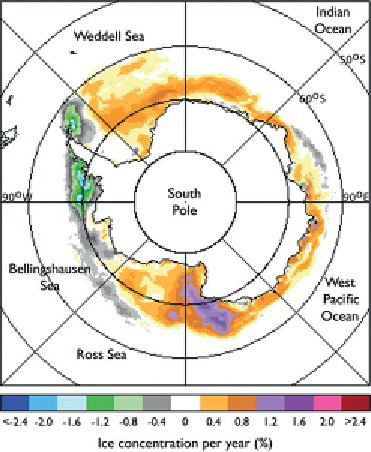Geoscience Reference
In-Depth Information
Figure 11.7 The variation in the concentration of sea ice
in per cent per annum over the period 1979
-
2006.
(Turner, J., R. A. Bindschadler, P. Convey et al. (2009).
Antarctic Climate Change And The Environment.
Cambridge: SCAR)
The rich and diverse Antarctic marine fauna
has many taxa (e.g. cnidarians, sponges and sea
squirts) but there are some remarkable absences
too, such as brachyuran crabs, lobsters and sharks.
The characteristics of the life history of Antarctic
animals normally involve slow growth, longevity,
intermittent recruitment and strong inter-annual
variability in population dynamics.
Many Antarctic marine taxa are stenothermal,
with upper limits around 4
C. The recent rate of
rise of the Southern Ocean temperature especially
to the west of the Antarctic Peninsula is unprecedented in the palaeorecord. Thus
there is a real possibility that some of the more sensitive animals may become
extinct. Given the complexities of even this marine ecosystem and the present quite
limited understanding of how it operates, the impacts of such losses are hard to
predict and could range from almost no change to complete collapse.
In addition to the strong natural cycles, humans have also had a signi
cant
role in shaping the Southern Ocean ecosystem, through the culling of the higher
predators (whales, seals and penguins) over the last two centuries. The impact of
humans could be described as causing a regime shift, whereby the system that was
dominated by the great whales is now in a new state where the top predators are
seals and birds.
The two main drivers of change in the marine environment in the twenty-
rst
century are climate change and
fishing. A central element of the Antarctic foodweb
is krill (
Euphausia superba
). It feeds on phytoplankton. Some estimates suggest that
there are about 600 000 billion krill in the Southern Ocean, and that they are the
most abundant animal in the world. However, its life cycle is being affected by
climate change through changes in sea ice concentrations.
The warming of the Antarctic Peninsula region is especially marked in winter.
This, combined with the strengthening north-westerly winds, has resulted in a
signi
6.8% per decade) in sea ice extent in the satellite era (since
1979). The change of wind patterns has also caused an increase in sea ice extent
in the Ross Sea region (4.5% per decade), giving a small overall increase in sea
ice extent around Antarctica (1% per decade). A signi
cant reduction (
-
cant proportion of the




Search WWH ::

Custom Search